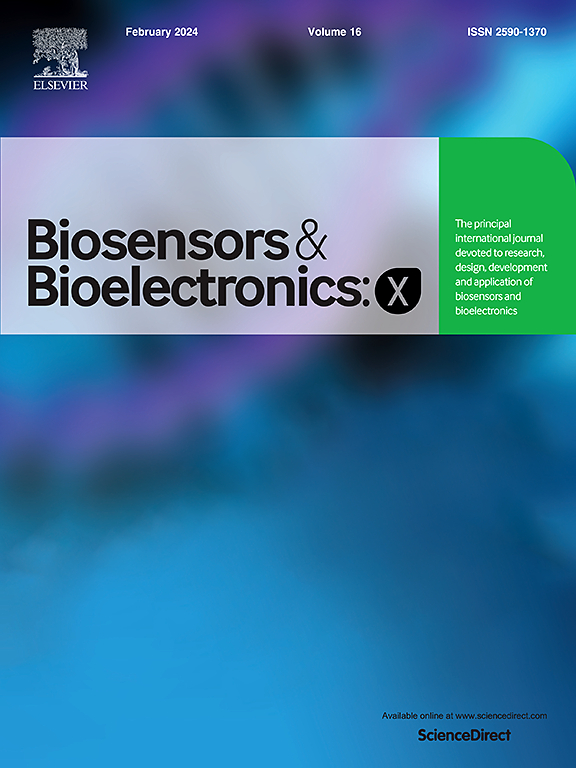可植入生物传感器的绿色纳米技术:医学应用中的生物相容性和功能集成
IF 10.61
Q3 Biochemistry, Genetics and Molecular Biology
引用次数: 0
摘要
绿色纳米技术越来越多地用于制造生物相容的、环境友好的植入式生物传感器,从而改变医疗诊断,而不需要传统制造带来的生态成本。与使用柠檬酸还原法合成的纳米颗粒相比,利用植物提取物、微生物和生物聚合物中的原位植物化学物质或微生物酶,可以合成对环境负责的纳米颗粒,包括石墨烯、碳纳米管(CNTs)、金纳米颗粒(AuNPs)、银纳米颗粒(AgNPs)和量子点(QDs),具有更高的细胞活力和胶体稳定性。绿色合成纳米材料与生物传感器的功能集成使纳米材料能够精确检测生物标志物,如葡萄糖、乳酸和蛋白质,具有高灵敏度、特异性和信号转导,适用于护理点应用和个性化医疗。物联网(IoT)集成在智能传感网络中的融合,在生物医学诊断和环境参数监测之间架起桥梁,为慢性疾病管理提供安全保障,同时最大限度地减少接触,提高数据可靠性并最大限度地减少能源消耗。从体外到体内应用的监管障碍和关键挑战,包括手术植入风险、校准漂移和慢性生物相容性问题。生物可降解电子、人工智能辅助分析和自动刺激响应纳米材料是未来的发展方向。生物可吸收传感器和自修复聚合物是创新的例子,突出了以患者为中心的可持续医疗保健的发展。绿色纳米技术打开了植入生物传感器的大门,通过连接材料科学、生物工程和临床实践领域,平衡环境责任和最先进的医疗创新。为了克服目前的障碍,实现植入生物传感器在精准医学中的全部潜力,本研究强调需要开发绿色方法。本文章由计算机程序翻译,如有差异,请以英文原文为准。
Green nanotechnology for implantable biosensors: Biocompatibility and functional integration in medical applications
Green nanotechnology is increasingly leveraged to create biocompatible, environmentally friendly implanted biosensors that transform medical diagnostics without the ecological costs associated with conventional fabrication. Utilizing in-situ phytochemicals or microbial enzymes in plant extract, microbe, and biopolymer synthesis methods enables environmentally responsible nanoparticle synthesis of Graphene, Carbon Nanotubes (CNTs), Gold Nanoparticles (AuNPs), Silver Nanoparticles (AgNPs) and Quantum Dots(QDs) with greater cell viability and colloidal stability compared to those synthesized using the citrate reduction method. The functional integration of green-synthesized nanomaterials into biosensors enables nanomaterials to perform precise detection of biomarkers, such as glucose, lactate, and proteins, with high sensitivity, specificity, and signal transduction, for point-of-care applications and personalized medicine. Convergence of Internet of Things (IoT) integration in intelligent sensing networks that bridge biomedical diagnostics and environmental parameter monitoring, safety for chronic disease management, while minimizing contact, enhances the reliability of data and minimizes energy usage. Regulatory hurdles and critical challenges in translating from in vitro to in vivo applications, including surgical implantation risks, calibration drift, and chronic biocompatibility issues. Biodegradable electronics, AI-assisted analytics, and automated stimuli-responsive nanomaterials that adjust to physiological changes are highlighted as future directions. Bioresorbable sensors and self-healing polymers are examples of innovations that highlight the move toward patient-centered, sustainable healthcare. Green nanotechnology opens the door to implanted biosensors that balance environmental responsibility with state-of-the-art medical innovation by linking the fields of material science, bioengineering, and clinical practice. To overcome current obstacles and realize the full potential of implanted biosensors in precision medicine, this study emphasizes the need to develop green approaches.
求助全文
通过发布文献求助,成功后即可免费获取论文全文。
去求助
来源期刊

Biosensors and Bioelectronics: X
Biochemistry, Genetics and Molecular Biology-Biophysics
CiteScore
4.60
自引率
0.00%
发文量
166
审稿时长
54 days
期刊介绍:
Biosensors and Bioelectronics: X, an open-access companion journal of Biosensors and Bioelectronics, boasts a 2020 Impact Factor of 10.61 (Journal Citation Reports, Clarivate Analytics 2021). Offering authors the opportunity to share their innovative work freely and globally, Biosensors and Bioelectronics: X aims to be a timely and permanent source of information. The journal publishes original research papers, review articles, communications, editorial highlights, perspectives, opinions, and commentaries at the intersection of technological advancements and high-impact applications. Manuscripts submitted to Biosensors and Bioelectronics: X are assessed based on originality and innovation in technology development or applications, aligning with the journal's goal to cater to a broad audience interested in this dynamic field.
 求助内容:
求助内容: 应助结果提醒方式:
应助结果提醒方式:


